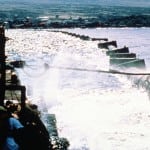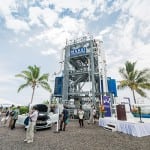The U.S. Department of Energy (DOE) last week awarded military-industrial giant Lockheed Martin a cooperative agreement contract worth $1.2 million to demonstrate innovative generation technologies that use the ocean’s thermal gradient.
Ocean Thermal Energy Conversion (OTEC) uses temperature differences of 36 degrees F or more between warm surface water and cold deep seawater to drive a heat engine.
The idea is not new, but it has never been scaled. Since the ocean’s temperature difference is relatively small, large volumes of seawater must be moved to generate commercial levels of power. The fabrication and installation of large-diameter cold water piping—required to reach depths of thousands of feet—represents one of the largest technical challenges to the successful installation and operation of an offshore OTEC system.
Under the terms of the DOE’s cooperative agreement, Lockheed Martin will demonstrate a cold water pipe fabrication approach using modern fiberglass technology and recent low-cost composite material manufacturing methods at prototype and pilot plant scales.
The company’s Manassas-based business will lead the OTEC effort; fabrication work will be performed at Lockheed Martin’s Advanced Technology Center in Sunnyvale, Calif. West Virginia University’s Constructed Facilities Center also will support the project for the pilot plant scale demonstration.
“OTEC holds the promise of providing clean, base-load electricity to energy markets that today rely almost exclusively on fossil fuels,” said Denise Saiki, vice president and general manager of Lockheed Martin’s Undersea Systems business unit.
“It’s conceivable, for example, that OTEC could enable Hawaii to achieve energy independence within a generation. Our independent research and development work to date has shown OTEC to be technically feasible. The next step is to demonstrate it on a commercial scale and this DOE contract will help accelerate our progress towards that goal.”
Lockheed Martin said that its experience with OTEC technology dates back 30 years. In 1974 the company, teamed with Bechtel Corp. and T.Y. Lin International, conducted a nine-month study on the practicality of generating electrical power at competitive prices from the solar energy naturally stored in the ocean’s thermal gradient.
The company followed that National Science Foundation-sponsored research with a self-funded four-month successful demonstration called Mini-OTEC, with support from the U.S. Navy, Makai Ocean Engineering, Dillingham Construction, and other firms.
That plant remains the “only floating, net-power producing OTEC plant ever built,” the company claims.
Lockheed Martin said it is currently exploring a range of potential applications for OTEC technology, including both electric power and fresh water generation. In addition to leveraging cross-corporate resources, the company is also working with Makai Ocean Engineering in Honolulu, Hawaii, and other companies and universities with expertise in the technologies crucial to the success of ocean thermal energy commercialization.
Sources: Lockheed Martin, Makai Ocean Engineering, DOE
DOE funds ocean thermal energy demonstration
SHARE:










